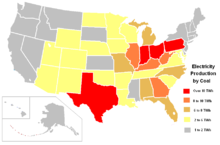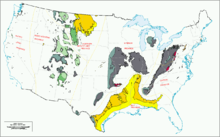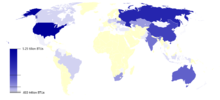- Coal power in the United States
-
 Sources of electricity in the U.S. in 2009.[1]
Sources of electricity in the U.S. in 2009.[1] See also: Coal mining in the United States
See also: Coal mining in the United StatesCoal power in the United States accounts for 46% of the country's electricity production.[1] Utilities buy more than 90 percent of the coal mined in the United States.[2]
In 2009, there were 1436 coal-powered units at the electrical utilities across the US, with the total nominal capacity of 338.732 GW[3] (compared to 1024 units at nominal 278 GW in 2000).[4] The actual average generated power from coal in 2006 was 227.1 GWh (1.991 trillion kilowatt-hours per year),[5] the highest in the world and still slightly ahead of China (1.95 trillion kilowatt-hours per year) at that time.[6] Back in 2000, the US average production of electricity from coal was 224.3 GWh (1.966 trillion kilowatt-hours per year).[5] In 2006, the U.S. consumed 1,026,636,000 short tons (931,349,000 metric tons) or 92.3% of coal for electricity generation.[7]
Contents
Recent trends, comparisons, and forecasts
Further information: Coal phase outAverage share of electricity generated from coal in the US has dropped from 52.8% in 1997 to 45.0% in 2009.[1]
The coal plants are mostly base-load plants and account for about 32% of the peak electricity production in the summer, when the electricity demand is the highest and the auxiliary (mostly non-coal) plants are added to the grid.[8]
As of 7/7/11, utility companies will shut down and retire aging coal-fired power plants following the Environmental Protection Agency's (EPA) announcement of the Cross-State Air Pollution Rule (CSAP).[9]
Canceled and slowed proposals
- On October 19, 2007, the Kansas Department of Health and Environment was the first government agency to reject a permit for a new coal-fired plant on the basis of carbon dioxide emissions which had been planned by the Sunflower Electric Power Corporation.[10]
- Southwestern Power Group's Bowie Power Station proposed an IGCC plant that was scrapped in favor of a natural gas plant. Regulatory uncertainty was cited as one of the reasons.
- A Florida Power & Light's Glades Power Plant proposed plant of 1,960 MW was rejected by the Florida Public Service Commission. Uncertainty over possible future carbon taxes was cited as one of the reasons.
- An air permit for a plant in Kentucky was rejected in August 2007 in a circuit court on the basis that the air pollution control analysis was inadequate.
- Cancellation of 8 (out of promised 11) proposed coal plants of former TXU Corporation in Texas by the current owners, Kohlberg Kravis Roberts & Co. and TPG, was finalized on October 15, 2007.[11]
Safety
Coal power has historically been known for being a dangerous working environment.[citation needed] The Mine Safety and Health Administration of the United States Department of Labor reports deaths by state and year for the period of 1996 to 2009; total deaths for that time frame were 437. In the US there were 47 deaths in 2006, 34 in 2007, and 30 deaths in 2008.
Accident types include:
- Power haulage - 47%
- Electrical - 13%
- Machinery - 9%
- Falling material - 7%
- Ignition/explosions - 7%
- Slips/falls - 4%
- Explosives - 4%
- Other - 9%
Reference: [1]
Environmental impacts
In the United States, three coal-fired power plants reported the largest toxic air releases in 2001 [12]:
- CP&L Roxboro Steam Electric Plant in Semora, North Carolina. The four-unit, 2,462 megawatt facility is one of the largest power plants in the United States.
- Reliant Energy's Keystone Power Plant in Shelocta, Pennsylvania.
- Georgia Power Bowen Steam Electric Generating Plant in Cartersville, Georgia.
The Environmental Protection Agency classified the 44 sites as potential hazards to communities, which means the waste sites could cause death and significant property damage if an event such as a storm, a terrorist attack or a structural failure caused a spill. They estimate that about 300 dry landfills and wet storage ponds are used around the country to store ash from coal-fired power plants. The storage facilities hold the noncombustible ingredients of coal and the ash trapped by equipment designed to reduce air pollution.[13]
Acid rain
Further information: Acid rainByproducts of coal plants have been linked to acid rain.
Sulfur dioxide emissions
86 coal powered plants have a capacity of 107.1 GW, or 9.9% of total U.S. electric capacity, they emitted 5,389,592 tons of SO2 in 2006 – which represents 28.6% of U.S. SO2 emissions from all sources.[14]
Carbon footprint: CO2 emissions
Main article: Greenhouse gas emissions by the United StatesEmissions from electricity generation account for the largest share of U.S. greenhouse gases, 38.9% of U.S. production of carbon dioxide in 2006 (with transportation emissions close behind, at 31%). Although coal power only accounted for 49% of the U.S. electricity production in 2006, it was responsible for 83% of CO2 emissions caused by electricity generation that year, or 1,970 Tg of CO2 emissions. Further 130 Tg of CO2 were released by other industrial coal-burning applications.[15]
Mercury pollution
U.S. coal-fired electricity-generating power plants owned by utilities emitted an estimated 48 tons of mercury in 1999, the largest source of man-made mercury pollution in the U.S.[16] In 1995-96, this accounted for 32.6% of all mercury emitted into the air by human activity in the U.S. In addition, 13.1% was emitted by coal-fired industrial and mixed-use commercial boilers, and 0.3% by coal-fired residential boilers, bringing the total U.S. mercury pollution due to coal combustion to 46% of the U.S. man-made mercury sources.[17] In contrast, China's coal-fired power plants emitted an estimated 200 ± 90 tons of mercury in 1999, which was about 38% of Chinese human-generated mercury emissions (45% being emitted from non-ferrous metals smelting).[18] Mercury in emissions from power plants can be reduced by the use of activated carbon.
Public debate
Advocates
In 2007 an advertising campaign was launched to improve public opinion on coal power titled America's Power. This was done by the American Coalition for Clean Coal Electricity (then known as Americans for Balanced Energy Choices), a pro-coal organization started in 2000.
Opposition
In the face of increasing electricity demand through the 2000s, the US has seen a "Growing Trend Against Coal-Fired Power Plants". In 2006 through 2007 there was first a bullish market attitude towards coal with the expectation of a new wave of plants, but political barriers and pollution concerns escalated exponentially, which is likely to damage plans for new generation and put pressure on older plants.[19] In 2007, 59 proposed coal plants were cancelled, abandoned, or placed on hold by sponsors as a result of financing obstacles, regulatory decisions, judicial rulings, and new global warming legislation.[20][21]
The Stop Coal campaign has called for a moratorium on the construction of any new coal plants and for the phase out of all existing plants, citing concern for global warming.[22] Others have called for a carbon tax and a requirement of carbon sequestration for all coal power plants.[23]
The creation in January 2009 of a Presidential task force (to look at ways to alter the energy direction of the United States energy providers) favors the trend away from coal-fired power plants.
See also
References
- ^ a b c http://www.eia.doe.gov/cneaf/electricity/epm/table1_1.html
- ^ http://www.pittsburghlive.com/x/pittsburghtrib/news/cityregion/s_586978.html
- ^ "Existing Electric Generating Units in the United States". Energy Information Administration. 2009. http://www.eia.doe.gov/cneaf/electricity/page/capacity/capacity.html. Retrieved 2010-07-27.
- ^ "Inventory of Electric Utility Power Plants in the United States 2000". Energy Information Administration. March, 2002. http://www.eia.doe.gov/cneaf/electricity/ipp/html1/t1p01.html. Retrieved 2008-06-19.
- ^ a b "Electric Power Annual with data for 2006". Energy Information Administration. October 2007. http://www.eia.doe.gov/cneaf/electricity/epa/epat1p1.html. Retrieved 2008-06-19.
- ^ See Wikipedia article on chinese Economy
- ^ "U.S. Coal Consumption by End-Use Sector". Energy Information Administration. July 25, 2008. http://www.eia.doe.gov/cneaf/coal/quarterly/html/t25p01p1.html. Retrieved 2008-08-29.
- ^ EIA - Electricity Data, Analysis, Surveys
- ^ http://thehill.com/blogs/e2-wire/677-e2-wire/170165-epa-finalizes-rules-for-cross-state-air-pollution
- ^ Washington Post. Power Plant Rejected Over Carbon Dioxide For First Time.
- ^ Souder, Elizabeth (2007-10-15). "Plans for 8 Texas coal plants formally canceled". The Dallas Morning News. http://www.dallasnews.com/sharedcontent/dws/bus/stories/101607dnbustxucoalplants.172c72818.html. Retrieved 2008-06-19.
- ^ http://www.ens-newswire.com/ens/jun2004/2004-06-03-10.asp
- ^ Associated Press - June 2009
- ^ "Technology Transfer Network: State Emission Index". U.S. Environmental Protection Agency. http://www.epa.gov/ttn/naaqs/ozone/areas/state/stindex.htm. Retrieved May, 2008.
- ^ "Inventory of U.S. greenhouse gas emissions and sinks: 1990–2006" (PDF). U.S. EPA. April 15, 2008. http://www.epa.gov/climatechange/emissions/downloads/08_CR.pdf. Retrieved 2008-08-29.
- ^ "Mercury emissions control R&D". U.S. Dept. of Energy. 2006-01-18. Archived from the original on 2007-12-22. http://web.archive.org/web/20071222224154/http://www.fossil.energy.gov/programs/powersystems/pollutioncontrols/overview_mercurycontrols.html. Retrieved 2008-01-27.
- ^ "Mercury study: Report to Congress (EPA-452/R-97-004)" (PDF). United States Environmental Protection Agency. December, 1997. http://www.epa.gov/ttn/oarpg/t3/reports/volume2.pdf. Retrieved 2008-07-31.
- ^ Streets D. G., Hao J., Wu Y. et al. (2005). "Anthropogenic mercury emissions in China". Atmos. Environ. 39 (40): 7789–7806. doi:10.1016/j.atmosenv.2005.08.029.
- ^ Palang Thai: The Growing Trend Against Coal-Fired Power Plants (USA)
- ^ "59 Coal Plants Cancelled, Abandoned, or Put on Hold in 2007," Lowbagger.org, 1/22/08
- ^ "Victories 2007," CoalSwarm
- ^ Want to stop global warming? STOP COAL!
- ^ Cap-&-Trade and Carbon Tax Legislation
External links
- Carbon-emissions culprit? Coal.
- Clean Air Watch.
- Statistics on existing U.S. coal-fired plants
- State Coal Profile Index Map
- Coal production in the United States – an historical overview
- Is America Ready to Quit Coal?
Energy in the United States Politics and law Energy Lobby · Energy policy · Energy Policy Act (1992 · 2005) · Offshore drilling debate · Oil politics · RPS · Secretary of Energy · New Energy For America · Energy law of the United StatesSources Material Solar by state Arizona · California · Hawaii · Nevada · New Jersey · New Mexico · OregonWind by state Environmental issues Organizations Coal power in North America Sovereign states - Antigua and Barbuda
- Bahamas
- Barbados
- Belize
- Canada
- Costa Rica
- Cuba
- Dominica
- Dominican Republic
- El Salvador
- Grenada
- Guatemala
- Haiti
- Honduras
- Jamaica
- Mexico
- Nicaragua
- Panama
- Saint Kitts and Nevis
- Saint Lucia
- Saint Vincent and the Grenadines
- Trinidad and Tobago
- United States
Dependencies and
other territories- Anguilla
- Aruba
- Bermuda
- Bonaire
- British Virgin Islands
- Cayman Islands
- Curaçao
- Greenland
- Guadeloupe
- Martinique
- Montserrat
- Puerto Rico
- Saint Barthélemy
- Saint Martin
- Saint Pierre and Miquelon
- Saba
- Sint Eustatius
- Sint Maarten
- Turks and Caicos Islands
- United States Virgin Islands
Wikimedia Foundation. 2010.




